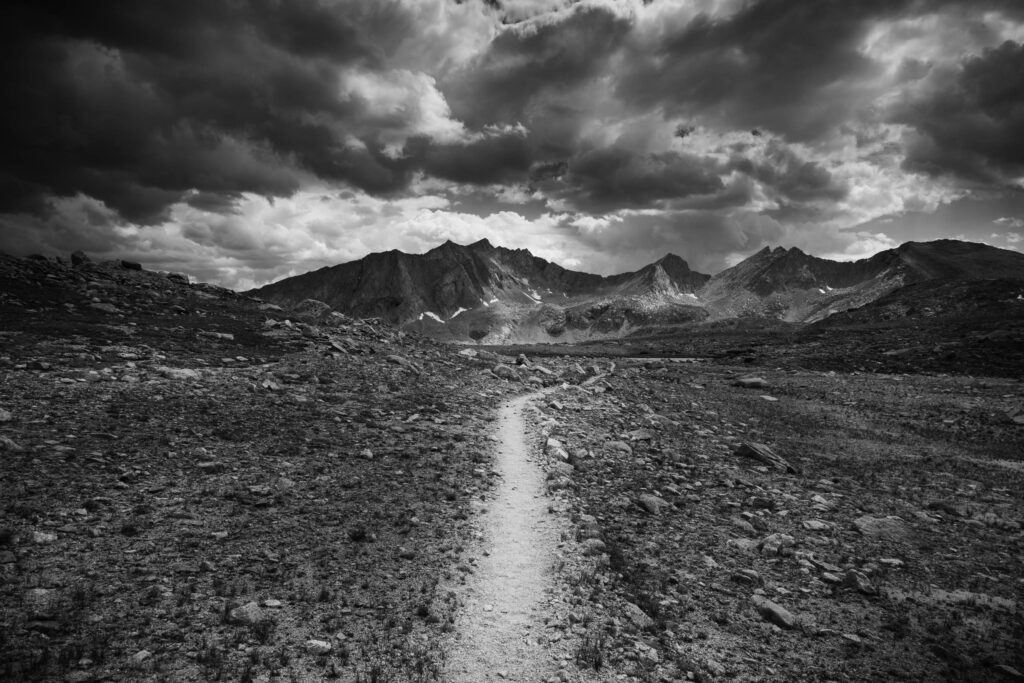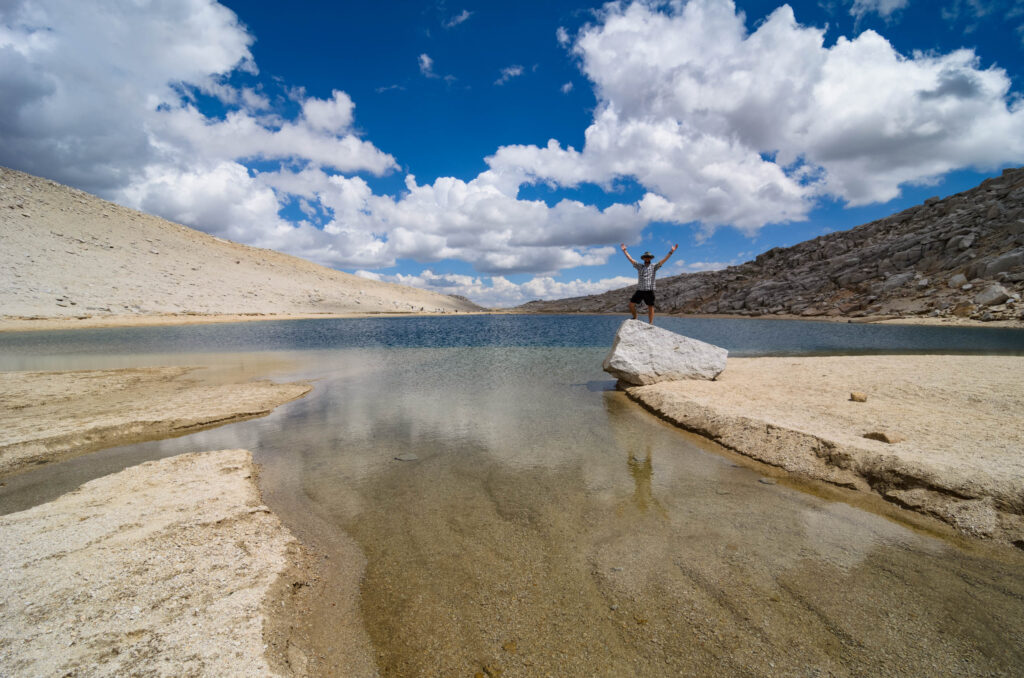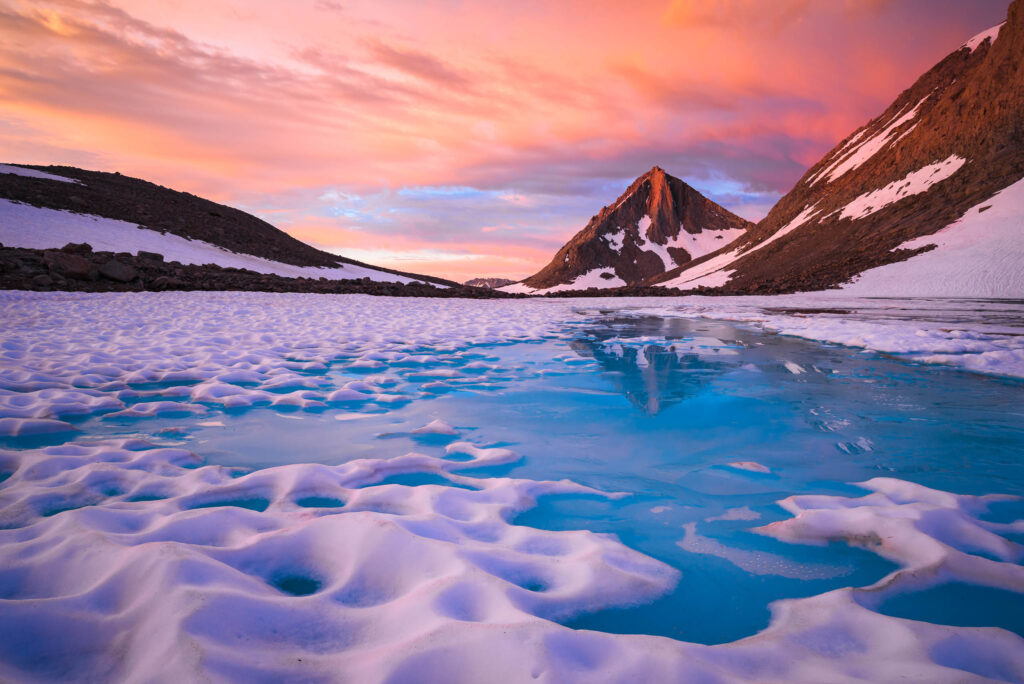
Finding Your Vision in the Wilderness and
Tips to Get Started
It’s 2 p.m. and I am hiding under a pine tree, eating sweet Thai chili tuna on an everything bagel. Around me, rain and hail crash down through the forest, sounding like the roar of an endlessly breaking ocean wave. Every few minutes the sound is punctuated by booming thunderclaps as lightning strikes a nearby lake.
Despite the fact that my shoes and backpack are getting soaked in the thunderous downpour, I’m thankful for the storm because it’s the only thing keeping the mosquitos at bay. As soon as the rain slows down they swarm me, their high-pitched buzz becoming an annoying symphony in my ears. To escape the little bloodsuckers, I heave my pack onto my back and stomp off into the drizzle.

Three miles later when I arrive in camp, my feet are squelching in my shoes, my shoulders and hips are groaning from carrying a 40-pound pack over 10 miles of trail, and my legs are covered with itchy bug bites.
And yet, when I finally drop my pack onto the soggy ground, I can’t help but laugh in delight. Because this is my favorite thing in the world: backpacking.

On the surface, backpacking seems terrible. It’s incredibly hard work, often uncomfortable, cold, and exhausting. There are endless bugs, the food does weird things to your digestion, and the risk of being mauled by a wild chipmunk is omnipresent.
And yet, trip after trip, I go back for more, because backpacking has brought me more moments of pure joy and beauty than any other activity. As a person, I find it wonderful. As a photographer, I find it sublime. And from now until the end of my days it’s something I will encourage every landscape photographer to try.
Here are my top five reasons why, plus some tips to help you have a successful first time out if you’re new to backpacking.
1. Backpacking gives you the opportunity to see truly unique landscapes.

Humans are naturally lazy. It’s part of our biology to conserve energy, and that means we tend to cluster around places that are easy to get to. I once read that 85 percent of the visitors to Yosemite National Park (photographers included) never get more than a quarter-mile from their cars. Considering that Yosemite is the size of Rhode Island, and that most of it is wilderness, this means that within just this one park there are vast expanses of stunning landscapes which are rarely visited, let alone photographed.

This is the case in every national park and every scenic area around the world. For every Tunnel View and Maroon Bells swarmed by photographers, there are dozens of unique and interesting locations existing in pristine and unpopulated splendor in the backcountry. If you want the opportunity to see something that very few other people have ever seen, hiking into the wilderness is a surefire way to do that.
2. The quality of the landscapes is extraordinary.
There are many spectacular front-country destinations. We all know about Yosemite Valley, Zion National Park, and Bryce Canyon. They are easy to drive to and stunningly beautiful. And yet, I can say unequivocally that the most beautiful things I have ever seen have been miles down a trail in the mountains. There are thousands of hidden gems and extraordinary jewels of scenic wonderment lying in wait for you out there in the woods. When you strap on a backpack and go to find them, I guarantee you will be rewarded with scenic beauty beyond your wildest dreams.

3. You earn your photographs, and every image becomes more meaningful.
It’s like most things in life: When photographs come too easily we take them for granted, and they become forgettable and disposable. If you saw a stunning sunset every single time you went to take pictures, you’d quickly lose interest in sunsets, and they would no longer be special. Thankfully, in reality, truly spectacular sunsets are rare. And it’s precisely that rarity that makes them valuable.
Picture a situation where to make even a mundane photograph, you have to sweat, grunt, and work hard for hours. That mundane photo instantly becomes much more meaningful because of the effort required to create it. Now imagine a photo with a great composition and beautiful light that took three days of hiking, hours of scouting, and toughing out a thunderstorm to achieve. It would go down as one of your most memorable images ever!
That’s backpacking in a nutshell. You will be working your ass off to get into the wilderness, and that will make the photography 10 times more rewarding. For me, every photo from the backcountry takes on a deeper significance because of that. Whether it’s the grandest of landscapes, or the simplest of small scenes, I can’t tell you how many photos I have from backpacking trips that are deeply significant and special to me. Not necessarily because they are the best photos in my portfolio, but simply because of the effort that went into creating them, and the powerful emotions their memories evoke.
4. You escape the influence of other photographers.
It’s happened to all of us: While researching a location we want to visit, we see an epic photo of the spot. This photo infects our brain and makes us incapable of seeking out any other composition. Case in point: When was the last time you saw a unique photo of Mesa Arch? There has become an accepted standard for what a Mesa Arch shot is supposed to look like. And when thousands of photographers descend on one location with the intention of creating a single photographic aesthetic, the creativity of landscape photography as a whole suffers because of it.
But so few images are created in the backcountry that you are free there from outside influence. When I arrive at some remote wilderness basin, I may have a rough idea of what it will look like, but the compositions are all there for me to find on my own. I get to wander around, exploring the pools, streams, angles, flower patches, leading lines, and dynamic peaks. Every composition I find is mine and mine alone.

When you photograph a location from an uninfluenced perspective, you can respond to the spot more organically and authentically. No matter what the conditions are, you can create photographs that take advantage of them. You’re not limited by some preconceived idea of what you’re supposed to shoot or how you’re supposed to shoot it. And that means you get to express yourself more clearly as an artist.

5. Most importantly, you get to fully immerse yourself in nature.
As landscape photographers we absolutely must build deep, personal relationships with the natural world. But let me ask you this: When was the last time you had an entire day that didn’t have some trappings of modern society in it, whether it was sitting in front of your computer editing photos, mindlessly scrolling Instagram, or even just listening to a podcast while you did chores? Can you recall a time when you felt truly connected to nature, with no distractions, no agenda, and no schedule? This is something that all humans should seek to experience, and landscape photographers doubly so. And in my opinion, the best way to do this is to spend more than 24 hours outside in the wilderness. Backpacking provides the perfect approach.
When you first try backpacking, a simple overnight trip is a digestible way to begin. Overnight trips are fun, beautiful, and relatively easy. But when you are arriving one day and leaving the next, you never truly escape all the cell phone signals, emails, and other distractions of modern life. So, once you’re used to it, I’d recommend a minimum of two nights for every backpacking trip. That way you have at least one full day when you are not in civilized society. You get an entire day to fully immerse yourself in nature. And when it’s just you in the landscape for an extended period of time, when you have no outside distractions, that’s when your relationship with nature truly flourishes.
If you can do a four- or five-day trip, it’s even better. For me personally, it is always the third day of a backpacking trip before I’ve fully cast off all of the anxieties of my day-to-day life and I feel truly at peace and connected to the landscape. I become much more present, I shake off my “have to’s and shoulds,” and I simply exist in the landscape. And getting into this state of being is critical to building my relationship with nature.
In addition, backpacking forces you to slow down. Landscape photography, ironically, is a stressful endeavor. I’ve noticed this countless times when leading workshops and photo tours. Photographers are always so concerned with getting there at just the right moment and finding just the right composition that they often are stressed out and highly anxious during experiences that should be peaceful and profound. Very rarely do we as photographers take the time to simply exist in the landscape and peacefully enjoy it. But when you are walking through a wild place at 1 to 2 miles an hour for the entire day, you can truly appreciate what makes a place special. The slow pace allows you to ponder, with deeper significance, what it is that you want to say in your photographs.
Backpacking also helps you understand yourself better as an artist. Once you get away from the constant distractions of everyday life, your mind has the opportunity to calm down. It will begin to focus on the meaning of not just your photography but of your life in general. And if you want to experience and express your full potential as an artist, it’s necessary to take the time to think about your place in the world, the purpose of your life, and exactly what you want to convey through your photography.
And that reason alone should be enough to convince any landscape photographer to get into the wilderness for a backpacking trip.
Bonus: Tips to get started backpacking as a landscape photographer
Truthfully, backpacking is a challenging hobby to start. There’s a lot of gear and upfront expense, it’s hard work, and it can be very intimidating. So here are a handful of my favorite ways to make your first backpacking trip as enjoyable as possible:
Go with experienced friends. They can help lighten your load, share communal gear, and let you know what you should and shouldn’t bring.
Borrow or rent gear to start. To keep the initial expense of backpacking down, rent or borrow as much gear as you can, including your tent, stove, sleeping bag and pad, and even jackets or base layers. You can rent a backpack, too, and I highly recommend that you go to a shop where experienced people can size your torso and fit you with an appropriate pack that is going to be comfortable.
Pretty much the only gear I think you shouldn’t rent is shoes. Make sure you are headed out with a pair of hiking shoes or boots that you know, trust, and love.
Start physical training. The training doesn’t have to be extreme, but you must get used to moving with a heavy pack on your back. Try loading up your backpack with some jugs of water and taking walks around your neighborhood to see how it feels. Do some squats and lunges to build those muscles. Every bit of training you do at home will pay dividends out on the trail.
Pick a high bang-for buck-location. There are many trailheads where even 1 to 2 miles of hiking will land you in a spectacular location to spend the night. Starting with a place like this will give you the opportunity to enjoy what is most special about backpacking without having to suffer through eight hours of hard hiking first. And again, a one-night trip is a good idea for your first time out.
Practice your TP system at home. Current best Leave No Trace practice is to pack out all of your trash, including used toilet paper. Although this is actually very easy to do with a few plastic zip bags, it tends to gross people out when they haven’t done it before. Practice putting your used TP in a zip bag at home so you can devise an easy system that works for you.
Treat yourself. Backpacking is hard work! So bring stuff to make the trip special. My personal favorite treats are chocolate, junk food like Cheetos (salty snacks are actually very important when you are sweating a lot), and a small flask of bourbon. Those little extras bring a disproportionate amount of joy when you are enjoying them beside an alpine lake.
Don’t overpack. This is my Number 1 tip. Trust me, you do not need a change of clothes for every day, or multiple jackets, or gimmicky gadgets. Just bring the bare essentials and keep your pack light. Your body will thank you!




